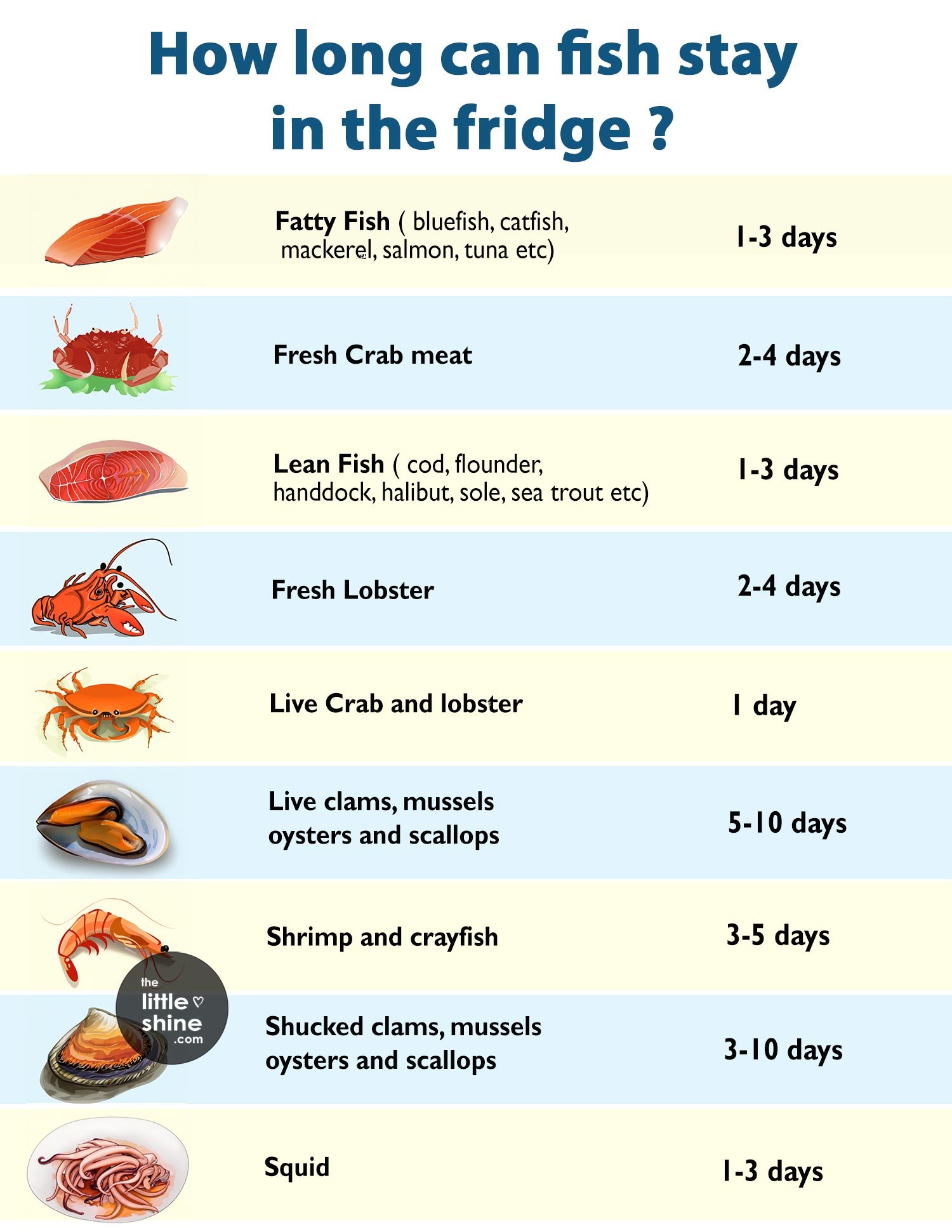Storing seafood the right way is essential because incorrectly stored seafood can be a major cause of severe food poisoning. Thus, knowing what the recommended refrigeration and freezing durations are is essential in maintaining its quality and for health reasons as well.

Here’s how long you can store fish and sea food in the fridge and freezer:
Lean Fish
Lean fish like sea trout, cod, haddock, sole, flounder, halibut etc., can be kept in the fridge for 1 to 3 days. These lean fish can be frozen for a maximum of 6 months.
Fatty Fish
Fatty fish like tuna, salmon, bluefish, catfish, mackerel, sardines etc., can last between 1 to 3 days in the refrigerator and can be frozen for up to 2 months.
Live Crab or Lobster
Live crab or lobster can be refrigerated for a maximum of 1 day and can be kept frozen for up to 4 to 6 months.
Live Shellfish
Live shellfish like clams, scallops, mussels, oysters etc, can be stored in the fridge for 5 to 10 days. In the freezer, these live shellfish last for about 3 months.
Fresh Crab Meat
Fresh crab meat will last a maximum of 4 days if kept in the fridge. While in the freezer, fresh crab meat will last for around 6 to 8 months.
Squid
Squid can be refrigerated for about 1 to 3 days and it can be kept frozen for up to 6 months.
Shrimp and Crayfish
Shrimp and crayfish will last for 3 to 5 days when kept in the fridge and it will remain in the freezer for 6 months.
Shucked Shellfish
Shucked shellfish like scallops, clams, mussels, oysters etc., will last for 3 to 5 days in the fridge and in the freezer, it will remain maximum for up to 4 months.
Safety Guide for Storing, Buying and Cleaning Seafood
- The ideal temperature for refrigerating fish and sea food is at 4°C or 40°F.
- The freezer temperature ideal for storing fish and sea food is – 18°C or 0°F.
- Whenever you buy any unpacked cooked seafood, make sure that it is separated from any raw seafood.
- If you use non-porous or plastic cutting boards for cutting and cleaning your seafood, wash them and disinfect them well after use to avoid cross-contamination. You can wash your cutting boards with hot water and a disinfectant for the best safety effects.
- If you have touched raw fish or shellfish with your bare hands, make sure to wash them a couple of times with soap or liquid hand wash and water.
- Make sure to disinfect your kitchen countertop and sink (if used), after cleaning and cutting any raw fish and shellfish.
Steps for the Safe Preparation of Seafood
Step 1: Thawing Seafood
When you want to thaw seafood that is frozen, place it in the fridge overnight before keeping it at room temperature.
In case you need to thaw any seafood quickly, you can immerse the zip lock bag in water, changing the water every 10 to 15 minutes until thawed or defrost in the microwave.
Step 2: Cooking Seafood
To know whether your seafood is cooked or not, here are some tips. For fish, the flesh will become opaque and it will separate easily with a fork. For crab, lobster, shrimp, and scallops, the flesh will become clear and firm. For oysters, mussels, and clams, the shells will open during cooking. In case any shells do not open, do not force them open, instead throw them out.
Step 3: Serving Seafood
Cold seafood shouldn’t be kept out of the refrigerator for more than 2 hours. You can serve cold seafood on ice, in case you need to keep it out longer than 2 hours.
For hot seafood, you can heat it just before you need to serve it, and do not let it stay out longer than 2 hours. Until you need to heat it, let it be refrigerated.
